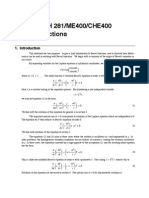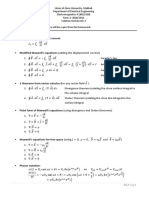Helmholtz Equation
Helmholtz Equation
Uploaded by
Abdul Naser Rafi'i AttamimiCopyright:
Available Formats
Helmholtz Equation
Helmholtz Equation
Uploaded by
Abdul Naser Rafi'i AttamimiCopyright
Available Formats
Share this document
Did you find this document useful?
Is this content inappropriate?
Copyright:
Available Formats
Helmholtz Equation
Helmholtz Equation
Uploaded by
Abdul Naser Rafi'i AttamimiCopyright:
Available Formats
Helmholtz equation
From Wikipedia, the free encyclopedia
Two sources of radiation in the plane, given mathematically by a function which is zero in the blue region.
The real part of the resulting field A, A is the solution to the inhomogeneous Helmholtz equation
The Helmholtz equation, named for Hermann von Helmholtz, is the elliptic partial differential equation
where 2 is the Laplacian, k is the wavenumber, and A is the amplitude.
Contents
[hide]
1 Motivation and uses o 1.1 Harmonic solutions 2 Solving the Helmholtz equation using separation of variables o 2.1 Vibrating membrane o 2.2 Three-dimensional solutions 3 Paraxial approximation
4 Inhomogeneous Helmholtz equation 5 References 6 External links
[edit] Motivation and uses
The Helmholtz equation often arises in the study of physical problems involving partial differential equations (PDEs) in both space and time. The Helmholtz equation, which represents the time-independent form of the original equation, results from applying the technique of separation of variables to reduce the complexity of the analysis. For example, consider the wave equation
Separation of variables begins by assuming that the wave function u(r, t) is in fact separable:
Substituting this form into the wave equation, and then simplifying, we obtain the following equation:
Notice the expression on the left-hand side depends only on r, whereas the right-hand expression depends only on t. As a result, this equation is valid in the general case if and only if both sides of the equation are equal to a constant value. From this observation, we obtain two equations, one for A(r), the other for T(t):
and
where we have chosen, without loss of generality, the expression k2 for the value of the constant. (It is equally valid to use any constant k as the separation constant; k2 is chosen only for convenience in the resulting solutions.)
Rearranging the first equation, we obtain the Helmholtz equation:
Likewise, after making the substitution
the second equation becomes
where k is the wave vector and is the angular frequency.
[edit] Harmonic solutions
It is relatively easy to show that solutions to the Helmholtz equation will take the form:
which corresponds to the time-harmonic solution
for arbitrary (complex-valued) constants C and D, which will depend on the initial conditions and boundary conditions, and subject to the dispersion relation
We now have Helmholtz's equation for the spatial variable r and a second-order ordinary differential equation in time. The solution in time will be a linear combination of sine and cosine functions, with angular frequency of , while the form of the solution in space will depend on the boundary conditions. Alternatively, integral transforms, such as the Laplace or Fourier transform, are often used to transform a hyperbolic PDE into a form of the Helmholtz equation. Because of its relationship to the wave equation, the Helmholtz equation arises in problems in such areas of physics as the study of electromagnetic radiation, seismology, and acoustics.
[edit] Solving the Helmholtz equation using separation of variables
The general solution to the spatial Helmholtz equation
can be obtained using separation of variables.
[edit] Vibrating membrane
The two-dimensional analogue of the vibrating string is the vibrating membrane, with the edges clamped to be motionless. The Helmholtz equation was solved for many basic shapes in the 19th century: the rectangular membrane by Simon Denis Poisson in 1829, the equilateral triangle by Gabriel Lam in 1852, and the circular membrane by Alfred Clebsch in 1862. The elliptical drumhead was studied by mile Mathieu, leading to Mathieu's differential equation. The solvable shapes all correspond to shapes whose dynamical billiard table is integrable, that is, not chaotic. When the motion on a correspondingly-shaped billiard table is chaotic, then no closed form solutions to the Helmholtz equation are known. The study of such systems is known as quantum chaos, as the Helmholtz equation and similar equations occur in quantum mechanics. If the edges of a shape are straight line segments, then a solution is integrable or knowable in closed-form only if it is expressible as a finite linear combination of plane waves that satisfy the boundary conditions (zero at the boundary, i.e., membrane clamped). An interesting situation happens with a shape where about half of the solutions are integrable, but the remainder are not. A simple shape where this happens is with the regular hexagon. If the wavepacket describing a quantum billiard ball is made up of only the closed-form solutions, its motion will not be chaotic, but if any amount of non-closed-form solutions are included, the quantum billiard motion becomes chaotic. Another simple shape where this happens is with an "L" shape made by reflecting a square down, then to the right. If the domain is a circle of radius a, then it is appropriate to introduce polar coordinates r and . The Helmholtz equation takes the form
We may impose the boundary condition that A vanish if r=a; thus
The method of separation of variables leads to trial solutions of the form
where must be periodic of period 2. This leads to
and
It follows from the periodicity condition that
and that n must be an integer. The radial component R has the form
where the Bessel function Jn() satisfies Bessel's equation 2Jn'' + Jn' + (2 n2)Jn = 0, and =kr. The radial function Jn has infinitely many roots for each value of n, denoted by m,n. The boundary condition that A vanishes where r=a will be satisfied if the corresponding wavenumbers are given by
The general solution A then takes the form of a doubly infinite sum of terms involving products of
These solutions are the modes of vibration of a circular drumhead.
[edit] Three-dimensional solutions
In spherical coordinates, the solution is:
This solution arises from the spatial solution of the wave equation and diffusion equation. Here and are the spherical Bessel functions, and
are the spherical harmonics (Abramowitz and Stegun, 1964). Note that these forms are general solutions, and require boundary conditions to be specified to be used in any specific case. For infinite exterior domains, a radiation condition may also be required (Sommerfeld, 1949). For function A(r0) has asymptotics
where function is called scattering amplitude and u0(r0) is the value of A at each boundary point r0.
[edit] Paraxial approximation
The paraxial approximation of the Helmholtz equation is (ref: "Introduction to Fourier Optics", 2nd ed., J. W. Goodman, p61-62):
where
is the transverse part of the Laplacian.
This equation has important applications in the science of optics, where it provides solutions that describe the propagation of electromagnetic waves (light) in the form of either paraboloidal waves or Gaussian beams. Most lasers emit beams that take this form. In the paraxial approximation, the complex magnitude of the electric field E becomes
where A represents the complex-valued amplitude of the electric field, which modulates the sinusoidal plane wave represented by the exponential factor. The paraxial approximation places certain upper limits on the variation of the amplitude function A with respect to longitudinal distance z. Specifically:
and
These conditions are equivalent to saying that the angle between the wave vector k and the optical axis z must be small enough so that
The paraxial form of the Helmholtz equation is found by substituting the above-stated complex magnitude of the electric field into the general form of the Helmholtz equation as follows.
Expansion and cancellation yields the following:
Because of the paraxial inequalities stated above, the 2A/z2 factor is neglected in comparison with the A/z factor. The yields the Paraxial Helmholtz equation.
[edit] Inhomogeneous Helmholtz equation
The inhomogeneous Helmholtz equation is the equation
where : Rn C is a given function with compact support, and n = 1, 2, 3. This equation is very similar to the screened Poisson equation, and would be identical if the plus sign (in front of the k term) is switched to a minus sign. In order to solve this equation uniquely, one needs to specify a boundary condition at infinity, which is typically the Sommerfeld radiation condition
uniformly in
with
, where the vertical bars denote the Euclidean norm.
With this condition, the solution to the inhomogeneous Helmholtz equation is the convolution
(notice this integral is actually over a finite region, since f has compact support). Here, G is the Green's function of this equation, that is, the solution to the inhomogeneous Helmholtz equation with equaling the Dirac delta function, so G satisfies
The expression for the Green's function depends on the dimension n of the space. One has
for n = 1,
for n = 2, where
is a Hankel function, and
for n = 3. Note that we have chosen the boundary condition that the Green's function is an outgoing wave for .
You might also like
- Pde BookletDocument23 pagesPde BookletBala RamNo ratings yet
- SSD Form Factor Version1 00 PDFDocument56 pagesSSD Form Factor Version1 00 PDFCampaigns Of HistoryNo ratings yet
- Communication System Simon Haykins PDFDocument2 pagesCommunication System Simon Haykins PDFJustin0% (1)
- Radio FrequencyCorrugatedantennaDocument22 pagesRadio FrequencyCorrugatedantennabkmmizanNo ratings yet
- Wave Equation For DummiesDocument6 pagesWave Equation For DummiesagonzalezfNo ratings yet
- Fourier TransformDocument13 pagesFourier Transformtiktiktak100% (1)
- Python Program To Generate Spherical HarmonicDocument11 pagesPython Program To Generate Spherical HarmonicWARSE JournalsNo ratings yet
- Lab 6 Franck HertzDocument9 pagesLab 6 Franck HertzEric Doctore Krage100% (1)
- Fourier Series Notes PDFDocument39 pagesFourier Series Notes PDFsudarshan poojaryNo ratings yet
- Anechoic Chamber Quiet Zone CalculationDocument5 pagesAnechoic Chamber Quiet Zone CalculationErick RdzNo ratings yet
- Parametric AmplifiersDocument11 pagesParametric AmplifiersDheeraj BahadurNo ratings yet
- Bode - Shannon - A Simplified Derivation of Linear Least Square Smoothing and Prediction Theory - 1950Document9 pagesBode - Shannon - A Simplified Derivation of Linear Least Square Smoothing and Prediction Theory - 1950Burak BarutcuNo ratings yet
- Dirac Notation of Quantum MechanicsDocument2 pagesDirac Notation of Quantum MechanicsReginald BernardoNo ratings yet
- Definition of Fourier Series and Typical ExamplesDocument17 pagesDefinition of Fourier Series and Typical ExamplesAura Paige Montecastro-RevillaNo ratings yet
- Fourier SeriesDocument61 pagesFourier SeriesMuhammad SaqibNo ratings yet
- Ch6 - Diatomic Vibration SpectraDocument15 pagesCh6 - Diatomic Vibration SpectraKamsNo ratings yet
- FFT Window Functions - Limits On FFT AnalysisDocument4 pagesFFT Window Functions - Limits On FFT AnalysisA. VillaNo ratings yet
- FFT For ExperimentalistsDocument24 pagesFFT For ExperimentalistsMara FelipeNo ratings yet
- Assignment 2 Quickfield - FinalDocument8 pagesAssignment 2 Quickfield - FinalAbu Uzair Nawfal100% (2)
- Application of Fourier AnalysisDocument5 pagesApplication of Fourier AnalysisMuhammad Ubaid Raza100% (1)
- Lecture 4. Macrostates and Microstates (Ch. 2) : Processes Are Not Inevitable, They Are Just Overwhelmingly ProbableDocument21 pagesLecture 4. Macrostates and Microstates (Ch. 2) : Processes Are Not Inevitable, They Are Just Overwhelmingly ProbablePreethi KesavanNo ratings yet
- Basics of Convolution and Fourier TransformDocument11 pagesBasics of Convolution and Fourier TransformLaura Ileana StoilescuNo ratings yet
- BehindTheLaplaceTransform IEEEspectrum91Document1 pageBehindTheLaplaceTransform IEEEspectrum91anabelle_23No ratings yet
- Quantum Theory and Functional AnalysisDocument17 pagesQuantum Theory and Functional AnalysispepeNo ratings yet
- An Introduction To Gaussian Geometry - GudmundssonDocument82 pagesAn Introduction To Gaussian Geometry - GudmundssonPanagiotis ChroniasNo ratings yet
- PotentiometerDocument10 pagesPotentiometerChirag SharmaNo ratings yet
- AttractorDocument7 pagesAttractorJose Luis CondoriNo ratings yet
- Volterra SeriesDocument5 pagesVolterra SeriesAnimasahun Olamide HammedNo ratings yet
- Geometry and Meshing Module: Niversity of Oronto Aculty of Pplied Cience and NgineeringDocument10 pagesGeometry and Meshing Module: Niversity of Oronto Aculty of Pplied Cience and Ngineeringsdfasdf7515No ratings yet
- 1 AutocorrelationDocument38 pages1 AutocorrelationpadikkatteNo ratings yet
- Fourier Analysis: Synthesis. For Example, Determining WhatDocument11 pagesFourier Analysis: Synthesis. For Example, Determining WhatEmmanuel TuffetNo ratings yet
- Fresnel and Fraunhofer DiffractionDocument56 pagesFresnel and Fraunhofer Diffractionmaitham100No ratings yet
- Wiener FilterDocument6 pagesWiener FilterSudipan SinghaNo ratings yet
- Electromagnetic Field TheoryDocument215 pagesElectromagnetic Field Theorysiaside67% (3)
- 12-Basic Knowledge of LDO Voltage Regulator enDocument19 pages12-Basic Knowledge of LDO Voltage Regulator enKirti Susan VargheseNo ratings yet
- Prepared By: Donabel de Veas-AbuanDocument31 pagesPrepared By: Donabel de Veas-Abuanrobert jNo ratings yet
- Jaynes-Cummings ModelDocument6 pagesJaynes-Cummings ModelFavio90No ratings yet
- Finite-Difference Time-Domain Method and Its ApplicationsDocument34 pagesFinite-Difference Time-Domain Method and Its ApplicationsFikir FikirNo ratings yet
- Eigen FilteringDocument6 pagesEigen Filteringlakshmipriya94No ratings yet
- SMT BookChapterDocument61 pagesSMT BookChapterfithis2001No ratings yet
- ECL Emitter-Coupled Logic PDFDocument8 pagesECL Emitter-Coupled Logic PDFsunilkmch505682No ratings yet
- Electron Ionization Electron Ionization (EI, Formerly Known As Electron Impact) Is An Ionization MethodDocument12 pagesElectron Ionization Electron Ionization (EI, Formerly Known As Electron Impact) Is An Ionization MethodDiego Ribeiro100% (1)
- Respect The Unstable PDFDocument14 pagesRespect The Unstable PDFMarcelo Quispe CcachucoNo ratings yet
- DSP SamplingDocument36 pagesDSP Samplingin_visible100% (1)
- Liaetal Cav 14Document17 pagesLiaetal Cav 14nicolasvNo ratings yet
- Laser Study MaterialDocument8 pagesLaser Study MaterialMohammed Rizwan MalikNo ratings yet
- Electronic Band StructureDocument17 pagesElectronic Band StructurepoomagalNo ratings yet
- Shannon's Information Theory - Science4AllDocument13 pagesShannon's Information Theory - Science4AllKevin E. Godinez OrtizNo ratings yet
- Franck Hertz ExperimentDocument15 pagesFranck Hertz Experimentlalal345No ratings yet
- Bessel Functions (Guide)Document22 pagesBessel Functions (Guide)Hoang Phan Thanh100% (1)
- WIEN2k PaperDocument31 pagesWIEN2k Paperdaniel.fidelisNo ratings yet
- Bloch FunctionsDocument5 pagesBloch Functionsalvaro562003No ratings yet
- Term Symbols and Selection RulesDocument3 pagesTerm Symbols and Selection RulesumeshfegadeNo ratings yet
- Landauer Buttiker Formalism PDFDocument15 pagesLandauer Buttiker Formalism PDFJacobNo ratings yet
- Comments On The Savitzky Golay Convolution Method For Least Squares Fit Smoothing and Differentiation of Digital DataDocument4 pagesComments On The Savitzky Golay Convolution Method For Least Squares Fit Smoothing and Differentiation of Digital DataHéctor F BonillaNo ratings yet
- Manual Plasma Diagnostics by Electrical ProbesDocument80 pagesManual Plasma Diagnostics by Electrical ProbesEUGENNo ratings yet
- Graphs and Tables of the Mathieu Functions and Their First DerivativesFrom EverandGraphs and Tables of the Mathieu Functions and Their First DerivativesNo ratings yet
- Magnetic Resonance Imaging: Physical Principles and Sequence DesignFrom EverandMagnetic Resonance Imaging: Physical Principles and Sequence DesignRating: 3 out of 5 stars3/5 (1)
- 2024 MI1046 ExercisesDocument8 pages2024 MI1046 ExercisesmacatinhNo ratings yet
- SoS (Mathematics)Document6 pagesSoS (Mathematics)achuthannayakiNo ratings yet
- 20.3.4 - Repeated Roots Reduction of OrderDocument16 pages20.3.4 - Repeated Roots Reduction of Orderanon_422073337No ratings yet
- NSDE Assignment 5Document2 pagesNSDE Assignment 5dev burmanNo ratings yet
- MA2001N Differential Equations: Lecture Notes For Week 2Document13 pagesMA2001N Differential Equations: Lecture Notes For Week 2Temesgen BihonegnNo ratings yet
- Coupled 1st Order ODEsDocument28 pagesCoupled 1st Order ODEsMuhammad Ahtisham AsifNo ratings yet
- D.E MTH210Document70 pagesD.E MTH210perfectNjaNo ratings yet
- Sma 2371 Pde DanDocument58 pagesSma 2371 Pde Danbradstreetgreg104No ratings yet
- 2 DStagnation FlowDocument8 pages2 DStagnation FlowHemanth Peddavenkatappa GariNo ratings yet
- Unit 2Document37 pagesUnit 2suhasbnand003No ratings yet
- CM mid sem 2Document1 pageCM mid sem 2supremegamerlmNo ratings yet
- EMT2-hw2 - SolDocument5 pagesEMT2-hw2 - SolSuper SpecialNo ratings yet
- Femtoc PDFDocument3 pagesFemtoc PDFmuti_khan20006003No ratings yet
- Practical-8 Plot The Integral Surfaces of A Given First Order PDE With Initial DataDocument9 pagesPractical-8 Plot The Integral Surfaces of A Given First Order PDE With Initial DataAashna GuptaNo ratings yet
- Instant ebooks textbook Practical Finite Element Modeling in Earth Science using Matlab 1st Edition Guy Simpson download all chaptersDocument40 pagesInstant ebooks textbook Practical Finite Element Modeling in Earth Science using Matlab 1st Edition Guy Simpson download all chapterswaderculliyq100% (4)
- SF2521NPDE lecture2AKDocument66 pagesSF2521NPDE lecture2AKBlooD LOVERNo ratings yet
- N1 - Classification of Differential EquationDocument5 pagesN1 - Classification of Differential EquationMuizz ZainolNo ratings yet
- Additional Mathematics - 2Document2 pagesAdditional Mathematics - 2Aditya GhoseNo ratings yet
- First ExerciseDocument2 pagesFirst ExerciseAtif ImamNo ratings yet
- First Order Linear Differential Equations: Chapter OutlinesDocument39 pagesFirst Order Linear Differential Equations: Chapter Outlinesحمامة السلامNo ratings yet
- Project Sem1 - 2019 2020Document4 pagesProject Sem1 - 2019 2020Hariss LuqmanNo ratings yet
- Computational Fluid DynamicsDocument10 pagesComputational Fluid Dynamicsajeeshg4002100% (1)
- MCQ 18ce310 Fourier Series and Partial Differential EquationsDocument8 pagesMCQ 18ce310 Fourier Series and Partial Differential EquationsGnanarajNo ratings yet
- Assignment 2 MAN-004Document1 pageAssignment 2 MAN-004Manoranjan pratap SinghNo ratings yet
- Linear First Order PDE: Type 2 Based On Rule II For Solving . .Document9 pagesLinear First Order PDE: Type 2 Based On Rule II For Solving . .Saad Ahmed SazanNo ratings yet
- Part7 (2) JJDocument23 pagesPart7 (2) JJthakurht2001No ratings yet
- Korman - ODEs - (AMS - MAA Textbooks 54.) Korman, Philip - Lectures On Differential Equations-MAA Press (2019)Document412 pagesKorman - ODEs - (AMS - MAA Textbooks 54.) Korman, Philip - Lectures On Differential Equations-MAA Press (2019)ANDREA NOEMI RAYON TRINIDADNo ratings yet
- Differential EquationsDocument231 pagesDifferential EquationsNasir NaeemNo ratings yet
- Analysis of Strong Stability Preserving Runge-Kutta Time DiscretizationDocument42 pagesAnalysis of Strong Stability Preserving Runge-Kutta Time Discretizationmoraesgabriel2No ratings yet

























































































